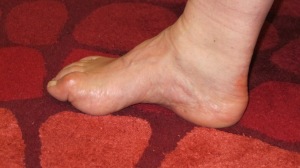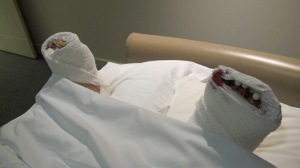Sydney. Australia: North Shore Private Hospital, 2 am-something in the morning.
I have always had high arches – high-arched feet, that is. And I’ve always been told there is nothing that can be done to correct them.
So I have lived with them for over 43 years. I would go over on my ankles, trip and fall, feel unstable on them, and I got tired on them. And I got tired of them. I wanted to love them as a part of my body, but I didn’t. They looked ugly to me. More importantly, they didn’t work the way feet are supposed to. Instead of a full range of motion from heel, ball to toes, my feet slapped down quickly from my heels to my toes. Instead of balancing me on the ground, my feet made me wobbly and imbalanced. I was supernating: using the outside of my feet, instead of the bottoms, to propel me forward. Instead of carrying me for miles, my feet would get weak and make me prone to tripping on them.
One of the things I didn’t know before I embarked on this journey was that I had CMT: Charcot-Marie-Tooth disease. Though it’s the most common genetic disorder worldwide, the diagosis was never made for me. I had never heard of it. Though high arches – or pes cavus – is CMT’s most common feature, my ‘deformed’ feet were never connected to the disorder. Though I was positively tested as a child for neuropathy, based on the lack of touch sensation in my toes and feet, no one ever let me know what that meant and doctors seemed to lose interest in my condition by my early teenage years. Though it’s described in detail on WIKIPEDIA – complete with a photo of ‘my’ foot, no physician ever told me about CMT. It’s the first search result on Google!
But it doesn’t matter now because I have found a team of doctors who have recognised the condition. More than a diagnosis, they have also operated on my ‘inoperable’ feet. I’m looking at those feet right now as they point up in their white casts; and I’m looking at my toes, no longer curled and clawed, little plastic balls on the ends of them, which are holding the wires that are straightening them. Marvellous.
And finally, 43 years into my life, I have learned that young children are having this condition corrected in their early years. I met another surgeon, just before I went under for my own surgery, who is learning the procedure as he specialises in treating children. Wonderful.
I want as many people as possible to know that pes cavus feet can be corrected – whether they suffer from it or not – so they can tell their friends, family or colleagues who do have the condition. That is why I’m writing this blog. Not enough people know about it, even though 1 in 3000 of us suffer from it. And most people do not fare as well as me for I have a mild case of CMT (subtype 1A, to be precise).
My husband, Craig, began to uncover this phenomenon via someone else’s blog in the US, thus kicking off his search for specialists in Australia. The search led to Dr Andrew Ellis, Dr Grace Warren, and Dr Garth Nicholson, all based in Sydney. These are the same three people who have brought me to this point in my journey: lying in North Shore Private Hospital in a white gown and white plastered feet at 2am in the morning, on the morning following my surgery, because I’m too excited to sleep.
I have yet to see the finished articles, but I will in 6 weeks time when the next set of (weight-bearing) casts come off. It’s at that point that I will be re-trained in walking. That’s the really exciting part, but I have some time to wait before I get to that point. In the interim, I plan to track my progress, learn more from my physicians about their own journeys in their specialisation, and share the highlights of my progress for whomever can benefit from my experience. If only one person who is affected can make use of the information in this blog, it will have been worth my efforts.
PS. I haven’t yet needed to touch my morphine drip as the pain is minimal. Amazing!


